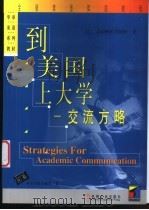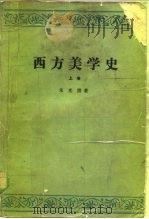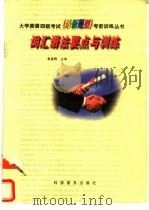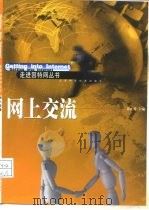《到美国上大学 交流方略》
| 作者 | (美)(J.斯蒂尔)Jocelyn Steer著 编者 |
|---|---|
| 出版 | 北京:机械工业出版社 |
| 参考页数 | 255 |
| 出版时间 | 1999(求助前请核对) 目录预览 |
| ISBN号 | 7111071905 — 求助条款 |
| PDF编号 | 81668838(仅供预览,未存储实际文件) |
| 求助格式 | 扫描PDF(若分多册发行,每次仅能受理1册) |

1Exploring College Culture1
PREVIEW OF THE CHAPTER2
Academic Topics2
Chapter Theme2
Taking Inventory:Your Own Thoughts2
Understanding College Terminology3
PART ONE:MAKING CROSS-CULTURAL CONNECTIONS4
Taking Inventory:Your Own Beliefs About Learning5
PART TWO:BECOMING FAMILIAR WITH CAMPUS LIFE8
Using Campus Services9
Learning About the Faculty10
Learing About College Administrators11
Attending Classes12
Taking Inventory:What Do You Think?12
Types of Classes12
PART THREE:TROUBLESHOOTING17
Choosing and Planninga Degree Program18
Dealing with Stress and Depression18
Making American Friends19
Dealing with Academic Concerns19
Dealing with Housing Concerns20
EVALUATING YOUR PROGRESS21
Gaining Expertise21
2Tightening the Nuts and Bolts23
PREVIEW OF THE CHAPTER24
Academic Topics24
Chapter Theme24
Taking Inventory:Your Experiences24
PART ONE:DEVELOPING STUDy READING SKILLS25
Taking Inventory:Your Textbook Reading Study Habits25
Your Textbook Reading Study Habits:Feedback26
Previewing a Text27
Identifying Your Purpose in Reading28
Survival Tips:The Textbook29
Highlighting a Text29
Highlighting for Factual and/or Historical Information30
Highlighting for Ideas31
Annotating a Text33
An Example of Annotation34
Managing Vocabulary35
Gaining Expertise36
PART TWO:TAKING NOTES IN CLASS36
Your Study Habits:Feedback37
Taking Inventory:YourNote-Taking Study Habits in Class37
Identifying the Parts of a Lecture38
Survival Tips:The College Lecture38
Learning Abbreviated Note-Taking40
Recognizing Signal Words44
Gaining Expertise45
PART THREE:TAKING TESTS46
Taking Inventory:YourTest-Taking Study Habits46
Your Study Habits:Feedback46
Preparing for the Test47
Anticipating Test Questions48
Survival Tips:Tests and Your Professor48
Identifying Your Study Habits49
Controlling Test Anxiety50
Taking the Test50
Understanding Test Prompts52
Taking Objective Tests58
Reviewing the Returned Test58
Gaining Expertise59
Getting More Help59
Test-Taking60
Taking Notes in Class60
Study Reading60
EVALUATING YOUR PROGRESS60
REQUIRED READINGS61
3Thinking and Communicating Critically87
PREVIEW OF THE CHAPTER88
Academic Topics88
ChapterTheme88
Taking Inventory:Your Own Thoughts88
PART ONE:SUMMARIZING STEP-BY-STEP91
Step One:Identifying the Controlling Idea92
Step Two:Identifying Key Supporting Ideas94
Step Three:Using Reporting Phrases to Acknowledge the Source97
Step Four:Adding Linking Devices99
Gaining Expertise99
PART TWO:PARAPHRASING SOURCES100
Learning Techniques for Paraphrasing101
Using Appropriate Synonyms101
Changing the Sentence Type104
Reducing a Clause to a Phrase106
Survival Tips:Paraphrasing107
Changing the Part of Speech107
Changing the Voice(Active or Passive)107
Gaining Expertise108
PART THREE:USING SYNTHESIS110
Step One:Summarizing Your Sources111
Step Two:AnalyzingYour Sources114
Step Three:Formulating Generalizations114
Step Four:Assembling Your Information115
Gaining Expertise116
EVALUATING YOUR PROGRESS117
4Compiling and Communicating Research119
PREVIEW OF THE CHAPTER120
Academic Topics120
Chapter Theme120
Taking Inventory:Your Research Paper Experience120
PART ONE:GETTING STARTED120
Getting Acquainted with Your Library121
Library Terminology121
Library Basics122
Library Tour124
Making Cross-Cultural Connections125
Setting a Schedule for Your Research Paper126
Brainstorming for Topic Ideas127
Survival Tips:Paper Topics to Avoid128
PART TWO:CONDUCTING A SEARCH129
Surveying Your Topic129
Searching for Books131
Searching for Periodical and Newspaper Articles133
Using Indexes134
Electronic Databases and Print Indexes135
Locating Periodical Articles in the Library138
PART THREE:ORGANIZING YOUR RESEARCH139
Gaining Expertise139
Using Other Sources of Information139
Limiting Your Topic140
Writing a Thesis Statement141
Evaluating Sources144
Reading and Taking Notes145
Types of Note Cards146
Writing an Outline148
Sample Outline149
PART FOUR:CITING AND DOCUMENTING SOURCES149
Quoting a Complete Sentence150
Quoting Part ofa Sentence150
Using Direct Quotations150
Quoting a Paragraph151
Knowing When to Use a Quotation151
Acknowledging Material That Is Not Quoted153
Compiling a Reference List155
Gaining Expertise156
EVALUATING YOUR PROGRESS158
REPRESENTATIVE SUBJECT ENCYCLOPEDIAS158
PERIODICAL INDEXES159
MODERN LANGUAGES ASSOCIATION(MLA)STYLE SHEET161
LIBRARY TERMINOLOGY163
5Communicating in Class167
PREVIEW OF THE CHAPTER168
Academic Topics168
Chapter Theme168
Making Cross-Cultural Connections168
Taking Inventory:Your Communication Comfort Level168
PART ONE:PARTICIPATING IN CLASS DISCUSSIONS169
Asking for Clarification and Information169
Taking Inventory:Your Own Thoughts171
Contributing to a Class Discussion172
Disagreeing173
Agreeing173
Survival Tips:Class Discussions173
Using Discussion Techniques173
Interrupting174
Soliciting Feedback174
Working in Groups176
Survival Tips:Dealing with Group Work176
PART TWO:GIVING FORMAL PRESENTATIONS177
Taking Inventory:Your Own Thoughts177
Presenting in Class178
Preparing a Talk on a Personal Topic178
Delivering a Talk179
Giving an Informative Presentation180
Giving a Persuasive Presentation182
Distinguishing Among Facts,Opinions,and Beliefs183
Evaluating Support183
Avoiding Problemsin Logic186
Gaining Expertise187
EVALUATING YOUR PROGRESS188
WORKSHEETS189
学习指导194
1999《到美国上大学 交流方略》由于是年代较久的资料都绝版了,几乎不可能购买到实物。如果大家为了学习确实需要,可向博主求助其电子版PDF文件(由(美)(J.斯蒂尔)Jocelyn Steer著 1999 北京:机械工业出版社 出版的版本) 。对合法合规的求助,我会当即受理并将下载地址发送给你。
高度相关资料
-

- 西方美学史 上
- 1981 北京:人民文学出版社
-

- 壮大な交流
- 1975.08 日本放送出版協会
-

- 战后美国外交史-从杜鲁门到里根 上
- 北京:世界知识出版社
-

- 丛调整公私关系到扩大土产交流
- 新群出版社
-

- 词汇语法要点与训练
- 1998 北京:科学普及出版社
-

- 战后美国外交史 从杜鲁门到里根 上
- 1994 北京:世界知识出版社
-

- 西方美学史 上
- 1963 北京:人民文学出版社
-

- 从下流到上流
- 1992 郑州:河南人民出版社
-

- 利益大角逐 美国的外交方略
- 1993 北京:北京工业大学出版社
-

- 大国方略 新中国外交五十年
- 1999 北京:中国物资出版社
-

- 中外美术交流史
- 1998 长沙:湖南教育出版社
-

- 当代美国交际流行口语
- 1992 北京:北京广播学院出版社
-

- 网上交流
- 1999 南京:江苏科学技术出版社
-

- 西方美学史 上
- 1964 北京:人民文学出版社
提示:百度云已更名为百度网盘(百度盘),天翼云盘、微盘下载地址……暂未提供。➥ PDF文字可复制化或转WORD
